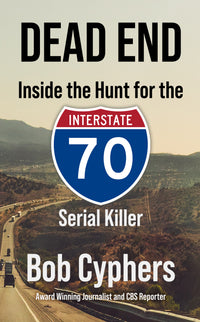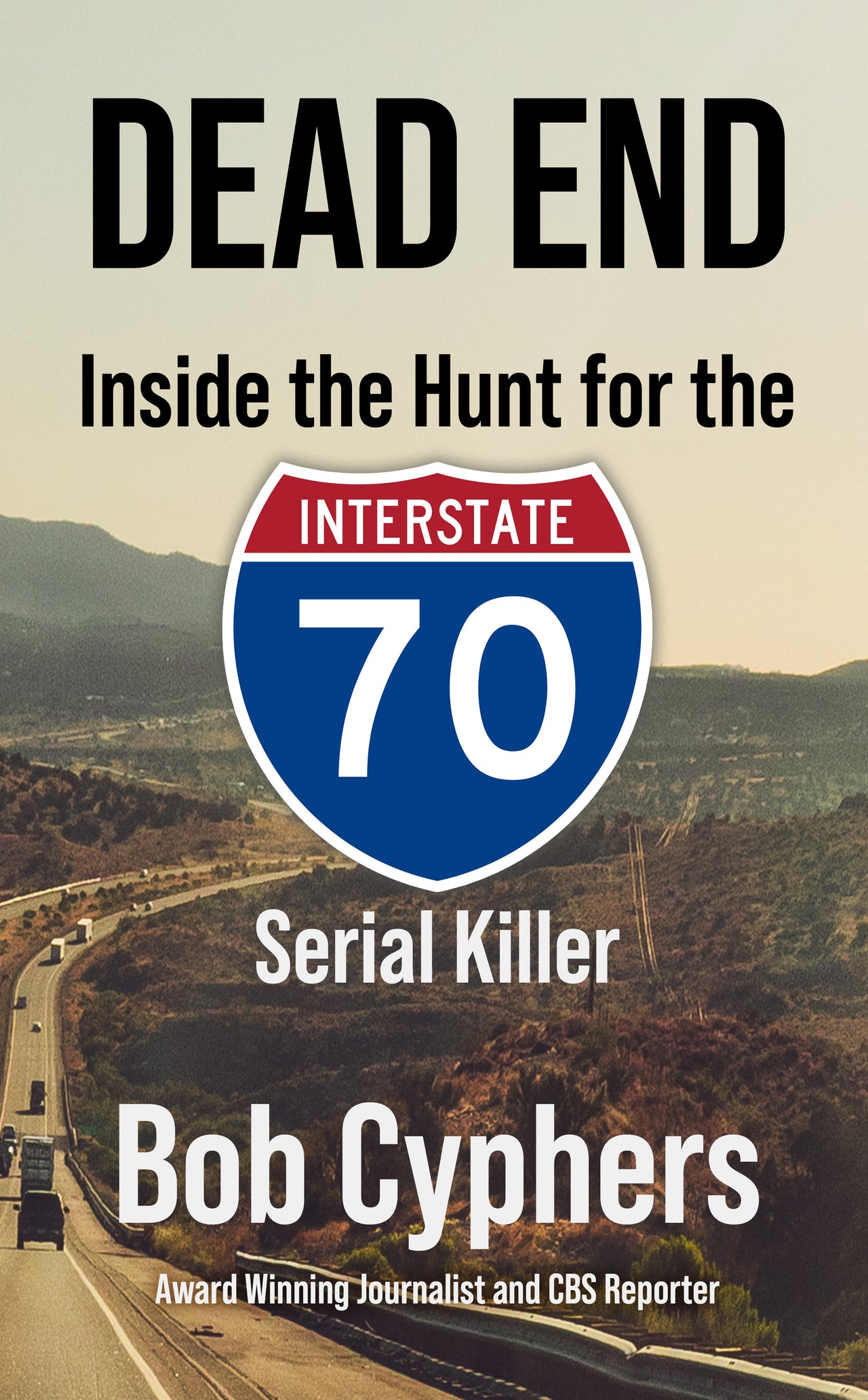Dead End: Inside the Hunt for the I-70 Serial Killer (Paperback)
$15.95USD


<?xml version="1.0" encoding="utf-8"?>
<!DOCTYPE html PUBLIC "-//W3C//DTD XHTML 1.1//EN"
"http://www.w3.org/TR/xhtml11/DTD/xhtml11.dtd">
<html xmlns="http://www.w3.org/1999/xhtml">
<head>
<title>Untitled</title>
<meta http-equiv="content-type" content="text/html; charset=iso-8859-1"/>
<style>
/* ePub CSS */
h1 {padding-top: 15%;}
.indent {text-indent: 5%;}
.center {text-align: center;}
.right {text-align: right;}
.margin {margin: 0 5%;}
.margin-indent {margin: 0 5%; text-indent: 5%;}
.bigmargin {margin: 0 5% 0 10%;}
.bigmargin-indent {margin: 0 5% 0 10%; text-indent: 5%;}
.hugemargin {margin: 0 5% 0 15%;}
.hugemargin-indent {margin: 0 5% 0 15%; text-indent: 5%;}
img {max-width: 94%;}
body {margin: 0 3%; text-align: justify;}
.spacer {padding-bottom: 1em;}
</style>
</head>
<body>
<h1 id="c6">CHAPTER 1</h1>
<div><b>“And then I started wondering, was Robin really the first? Could there have been others before her?”</b></div>
<div class="spacer"></div>
<div class="indent">The phone rings every April 8 in Susan Fuldauer’s Indianapolis home. She will pause what she is doing, look at the incoming number, glance quickly at the calendar, and smile. Mike Crooke never, ever forgets.</div>
<div class="indent">“I just pick up the phone every April 8 and I call her,” Crooke says. “And I say to her ‘Hey Susan, I am not calling you because I have some good news to report about.’ It is more like ‘Hey Susan, I have not forgotten about you, your family or your sister Robin, and I never will. I am still out here plugging away. I am still out here trying to do my best.’ I always call her on the anniversary of that day and just remind her that she and her family are still in my thoughts, and they always will be.”</div>
<div class="indent">Crooke, the longtime sergeant of the Indianapolis Police Department, has remembered since April 8, 1992, the day the Robin Fuldauer nightmare began. He is long since retired, but he has never, ever forgotten.</div>
<div class="spacer"></div>
<div class="center">***</div>
<div class="spacer"></div>
<div class="indent">November 2021. Our crew left St. Louis in the early morning and headed east, photographer Chuck Delaney driving, producer JJ Bailey riding shotgun, and me in the backseat taking notes of the scenery along Interstate 70. As we drive along the highway I picture in my mind what the killer saw 30 years ago. Pick an exit to get off, quickly find a small store in a strip mall, make sure a woman is working alone, get in and get out without being seen, and leave a body behind. Surely it is not that easy. It simply can’t be.</div>
<div class="indent">Our first stop, like the killer’s, was Indianapolis. Interstate 70 east through Indy to the 465 loop, then a quick jaunt north. The killer wasn’t patient, he took the first possible exit, Pendleton Pike. He could have headed east or west. He could have picked any woman, anywhere, to kill. He chose to turn left at the light and go west. And then he immediately had options to kill on both his right and left. He picked the Payless shoe store.</div>
<div class="indent">The Indianapolis police detectives still working the Robin Fuldauer case were waiting for us when we arrived. Like other major cities, Indianapolis had seen a huge spike in homicide cases recently. Their staff was spread thin trying to solve not only murders that seemed to be happening daily, but cold cases that had piled up over the years. Clearance rates, or rates of solving homicides, ranged around 50 percent. That meant hundreds of unsolved cases piled up each year. After 30 years, an unsolved homicide is often a file, in a box, in a closet, never to be opened again.</div>
<div class="indent">“We have thousands of unsolved cases over the years,” said Captain Roger Spurgeon of the Indianapolis Police Department. “And more are coming every week. It is overwhelming. You do the best you can do, and then another case lands on your desk.”</div>
<div class="indent">Spurgeon and I looked around the busy Pendleton Pike area and I knew we were reading each other’s minds: The killer could have stopped anywhere.</div>
<div class="indent">“Why here, do you think?” I voiced to the detectives. “He could have stopped anywhere. Why do you think he stopped here?”</div>
<div class="indent">The men looked at each other and shook their heads. A question that has never been answered here, or at any of the other crime scenes.</div>
<div class="indent">“This would be one of the last places you would think he would strike,” said Columbus Ricks, one of the Indianapolis detectives. “Look at how busy this area is.”</div>
<div class="indent">But Spurgeon guessed there was a method in the killer’s madness. “I think there would have been a variety of stores for him to choose from in the area,” Spurgeon said. “It was just a matter of whatever our suspect was looking for at the time. You have all of this busy traffic around this area, all of this movement, all of these people coming and going so quickly. Unless somebody really stood out to someone as behaving oddly or looking oddly, you could really go about your business with relative anonymity and nobody would ever really pay you any attention.”</div>
<div class="indent">I pointed to the busy Speedway gas station that was literally steps from the Payless shoe store. Customers were filling their tanks, and numerous people were coming and going inside the store by the minute.</div>
<div class="indent">“Was the gas station there in 1992?” I asked Spurgeon.</div>
<div class="indent">He nodded yes.</div>
<div class="indent">“That does not make any sense,” I said. “You would have to be a fool to kill somebody with this many potential witnesses around.”</div>
<div class="indent">Ricks and fellow detective David Ellison both laughed.</div>
<div class="indent">Spurgeon nodded again. “Welcome to the world of the I-70 serial killer where nothing makes any sense.”</div>
<div class="indent">I walked up to the front door of the gas station, and then took a few steps to the Payless store. It took me less than 20 seconds. Ellison and Ricks stood alongside Spurgeon and watched me make the walk.</div>
<div class="indent">“Twenty seconds,” I hollered at them. “No way somebody is killing somebody with all of these people just 20 seconds away.”</div>
<div class="indent">I looked at Spurgeon again. He nodded and I shook my head. “No way,” I muttered to myself.</div>
<div class="indent">I kept walking between the gas station and shoe store, and then returned to the detectives.</div>
<div class="indent">“Let me make sure I have this right,” I said. “He somehow chooses this busy location in the middle of the day. Then he kills Robin with all these people around. And then what, he just disappears?”</div>
<div class="indent">“Pretty much,” said Ellison. “Pretty much.”</div>
<div class="indent">Robin Fuldauer was not sure where life was taking her yet, but she was moving very quickly. She was the salutatorian of her Lawrence Central High School class, located just down the street from the Payless shoe store. She graduated a few years later from Indiana University. And now she had already risen to become a manager for Payless.</div>
<div class="indent">Sometime around 1pm on that April day, a serial killer was about to embark on a month-long journey, one that would take him to five cities, leaving six body bags behind. He was patrolling Pendleton Pike Road, looking for his first victim.</div>
<div class="indent">Receipts from the store show the last purchase was made at 1:12pm. Police believe the killer was likely in the store at the time, saw the only other customer leave, and then made his move. He forced Fuldauer into a storage room in the back of the store, made her kneel, then shot her twice in the back of the head, execution style, with a .22 caliber handgun. There was no sign of any struggle inside the store. The killer then rummaged through the cash register, taking less than $100. Police believe he left through a back door by 1:30pm, leaving Fuldauer lying dead behind a closed door. For the next hour, Payless customers would have their run of the store, with nobody in sight.</div>
<div class="indent">“I don’t believe there was an opportunity for anybody to go inside the store and observe that there was a body there,” Spurgeon said.</div>
<div class="indent">The Payless store had little in the way of store security. Just a bell that would ring when a new customer arrived.</div>
<div class="indent">Police records showed a woman named Lucretia Gullett was working at the Speedway gas station the day Fuldauer was killed. It was Gullett who discovered Robin’s body and called police.</div>
<div class="indent">Before arriving in Indianapolis, I began the task of searching for Lucretia Gullet.</div>
<div class="indent">“Is this Lucretia Gullet?” I asked the woman on the other end of the phone.</div>
<div class="indent">“It is,” she said.</div>
<div class="indent">“Ma’am,” I said, “I am a reporter working on a serial killer from 1992. And I believe you found the body of his first victim. A woman named Robin Fuldauer in the Payless shoe store.”</div>
<div class="indent">Gullett paused on the other end. “I did not really find her body. But yes, I was there, and I called the police. But what did you say about a serial killer?”</div>
<div class="indent">I told Gullett her Payless killer went on to kill numerous other women across the country.</div>
<div class="indent">“What?!” she screamed into the phone.</div>
<div class="indent">And I realized she was unaware. “Do you still live around Indy?” I asked her.</div>
<div class="indent">“I do,” she said.</div>
<div class="indent">“I am coming to town,” I told her. “Would you meet with me?”</div>
<div class="indent">“I will,” she said. “And did you say serial killer?” Apparently, she was still coming to grips with this.</div>
<div class="indent">I stood by the Speedway gas station with my crew and the police detectives, and watched as a woman parked her car and walked toward us.</div>
<div class="indent">“I am looking for Bob,” she said.</div>
<div class="indent">“Hi Lucretia,” I said, and we shook hands.</div>
<div class="indent">We began walking around the area. “This brings back a lot of memories,” she said.</div>
<div class="indent">“Have you been back here since…?” I asked.</div>
<div class="indent">“No,” she said as she looked around. “Thirty years is a long time. I just avoided coming around here.”</div>
<div class="indent">I asked Gullett to take me back to that day, as best she could.</div>
<div class="indent">“My shift at the Speedway gas station was ending at 3pm. I was almost getting off work to go home when I received a phone call from a man who said he was the district manager of the Payless store. It was probably around 2pm,” Gullett remembered. “He told me that he had been calling the shoe store for quite a while, but that no one was answering the phone there. He was really concerned, so I told him I would go next door to Payless and see what was going on over there.”</div>
<div class="indent">Gullett and I made the 20 second walk from one store to the other. “What happened when you walked in?” I asked.</div>
<div class="indent">Gullett paused at the door. “This is hard,” she said. “I walked up to the front door, opened it up and looked around. I did not see anybody. No manager, no customers. I looked over to the left and noticed that the cash register was open and then I went through the aisles, but nobody was around. I really was not sure what was going on, but I knew it was not right. Then I heard someone talking in the back of the store, so I went back there and I saw a woman who had a child with her. They were looking at some shoes. I asked her to please leave, and told her something was wrong. I did not know what was happening, but I knew something was wrong. So I just immediately stopped looking around and called the police. I was probably only in the store for about 10 minutes. And then I just waited for the police to arrive.”</div>
<div class="indent">Police records show they arrived at the scene around 3pm. When they did, Gullett said she then stood watch over the front door while detectives made their way inside. She watched them search the store before heading towards the back. And then she saw them open a closed door and look inside.</div>
<div class="indent">“One officer looked down to the right,” Gullett said, “and I could tell he was shocked at what he saw.”</div>
<div class="indent">Incredibly, some 30 years after Robin Fuldauer was murdered, Gullett says she was not aware the homicide scene she walked into three decades ago became linked to a serial killer, or that it was not solved all these years earlier. “I just became aware of that when you called me,” she said.</div>
<div class="indent">“You did not follow the case over the years as it exploded?” I asked.</div>
<div class="indent">“No,” she said. “I was shocked when you told me it was a serial killer. I was like, whoa! That is when I put two and two together, and like, wow!”</div>
<div class="indent">Brought back to the scene, and meeting new detectives for the first time. Gullett is now spending time detailing the case to police again.</div>
<div class="indent">“They wanted to know if there was anything else I ever came up with or thought about.” And then she winked and smiled. “Maybe. Maybe. It might just be a coincidence. But yes, I hope I can help.”</div>
<div class="spacer"></div>
<div class="center">***</div>
<div class="spacer"></div>
<div class="indent">Roger Spurgeon was an Indianapolis police officer at the time of Robin Fuldauer’s murder, not yet working in homicide. Now, he has been with the police department more than 25 years, most of them in the homicide unit. He would inherit the Fuldauer case, and says that in spite of the busy area, and in spite of the busy time of the day, early leads in the case quickly fizzled. “At first, because there was a small amount of cash taken, detectives thought it was likely a robbery that somehow turned into a homicide. They had a variety of potential suspects they were looking at in the very beginning. But If you describe a suspect as somebody you really have a keen interest in because of some sort of an evidentiary link or eyewitnesses, no, there was nothing there which stood out to the investigators at that time.”</div>
<div class="indent">Detectives immediately began canvassing the area on Pendleton Pike. The first witness they found was the store manager at MAB paint, across the street from the Payless, He told police he saw a strange looking man carrying a long bag. The witness said he watched the man repeatedly circling the Payless store, and then watched as the man sat down at a curb nearby for nearly 30 minutes. And then around 2pm, he suddenly disappeared from sight. The witness told police the man appeared to either be on drugs or had a mental problem.</div>
<div class="indent">Police would only locate less than a half dozen potential witnesses. One of them said they saw a man who matched what the earlier witness said calmly trying to hitch a ride along the highway. Police found a couple of other witnesses in the area who thought they saw something, but none of those leads panned out.</div>
<div class="indent">Detective Columbus Ricks is part of the Indianapolis Unsolved Homicide Unit. Like Spurgeon, he was also an Indianapolis police officer at the time of the Fuldauer murder. “The homicide investigators tracked down almost everybody that was said to have seen something in the area or had been seen by someone. They all had enough of an alibi to eliminate them. The descriptions of the suspect were all black males…” Ricks said, shaking his head. “And within days, after Wichita, the detectives knew the killer was a white male.”</div>
<div class="indent">I looked at Ricks and laughed. “How stupid,” I said.</div>
<div class="indent">“Not as easy as it seems on TV,” Ricks laughed again.</div>
<div class="indent">And then came the question: How did the killer get away? How did he simply walk out of the store in the middle of the day, with people all around, and disappear into thin air?</div>
<div class="indent">“I think he could have easily parked a vehicle on one of these residential side streets and casually walked to it,” Spurgeon said. “And nobody would have paid any attention to him unless he was acting strangely. Obviously, he had to have some sort of wheels to get from point A to point B. But we still do not have a good handle on that. Detectives had a lot of different theories at the time.”</div>
<div class="indent">Our crew walked around the area near the store. Busy streets in front, a side street on the side, and an older residential section behind it. Spurgeon appeared to be on target. The most likely answer was the killer parked a car on one of the residential streets, walked calmly to the Payless store, murdered Robin Fuldauer, and then walked back to his car.</div>
<div class="indent">Time moves forward. Today, a Batteries Plus store sits where the Payless Shoe store stood in 1992. But what has not changed is that police departments in five cities are still digging, talking to each other, and hoping for a DNA match.</div>
<div class="indent">“Science was not as developed then as it is now,” said Ricks. “We are going to see if DNA and new technology can assist us in solving this case.” Ricks added that another new witness may have recently emerged. Until then, we wait. The police. The families. Everyone. And they all understand that they are waiting for an answer that may never come.</div>
<div class="indent">Robin’s sister Susan will never forget that day. You can still hear the sadness in her voice. “My husband found out about Robin first. He came home and told me. It was just so incredibly hard to process. It was something completely out of the realm of expectations. I immediately went to pick up my daughter and then we went to the Payless store. There was so much activity at the scene it was hard to believe. It is just a nightmare that you live through and cannot possibly process. It is just very hard to describe.”</div>
<div class="indent">And then just a few days later, the bombshell of Wichita came, where 700 miles away and just three days after Robin Fuldauer was murdered, Patricia Magers and Patricia Smith were killed in the same fashion. And almost immediately, police were hit with a stunning reality: The same gun used in Indianapolis was used in Wichita. It seemed impossible with the time frame. But, suddenly, Indianapolis and Wichita had a serial killer on their hands.</div>
<div class="indent">“Then it all became just surreal,” Susan said. “Wichita was connected to my Robin? And again, look at the pattern. So cold blooded. Another busy, noisy store. And then the others soon came rolling in. And then I started wondering, was Robin really the first? Could there have been others before her? This was now totally beyond belief. And then our family began grieving not just for Robin, but for all of these other families going through the same exact nightmare that we were going through.”</div>
<div class="indent">There is another heartbreaking twist of fate to Robin’s story. She was not supposed to work that day, but another employee called in sick. The Payless store was short-staffed, so Robin came in to cover the shift, as she had so many times before.</div>
<div class="indent">After all these years, one thought keeps sticking in Susan’s mind. “I know you cannot turn the clock back. But I usually went by Robin’s store on most days after I got off of work, just to make sure she was okay. For some reason, I did not go by that day. And I always ask myself, ‘Could I have possibly done something? Could I have possibly stopped something?’”</div>
<div class="indent">Susan Fuldauer is realistic about the chances of finding the killer after all these years. But she says she will always remain hopeful. “We have always maintained hope that Robin’s murder will someday be solved. Maybe the killer is in jail somewhere. Maybe he is no longer alive. But, like the detectives tell us, we have new technology now. We have new DNA techniques. We have hope. It does not bring Robin or the other victims back. But to know that he might be stopped, and he can never do anything like this again, that would be a major victory for our family.”</div>
<div class="indent">Mike Crooke, who has seen everything in his 52 years in law enforcement, insists the case can someday be solved. “I am still hopeful we will resolve this. We did not have the advances in science 30 years ago that we have now.”</div>
<div class="indent">Robin Fuldauer was 26 years old. She was the first known victim of the I-70 serial killer. And while it all began in Indy, sadly, it did not end there. And on April 8, pick a year, any year, Mike Crooke will pick up the phone and call Susan Fuldauer. She will smile. They will talk. And they will cry. “It is so kind and considerate of Mike to reach out to my family,” Susan said. “He reminds us that Robin will never ever be forgotten. I appreciate that so very much. We do not talk about the what ifs, because this was such a heinous crime. It is just very comforting to know that Mike remembers us each year. That amount of kindness is really wonderful and will never be forgotten.”</div>
<div class="spacer"></div>
<div class="spacer"></div>
</body>
</html>

